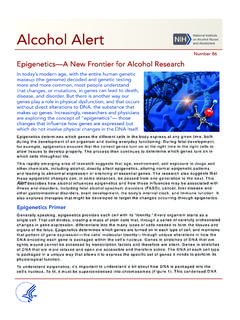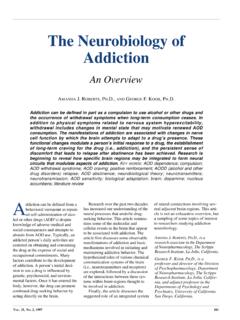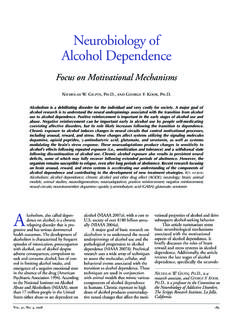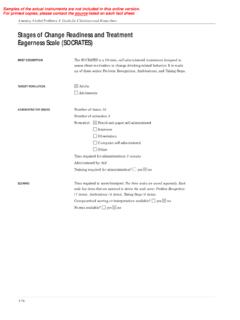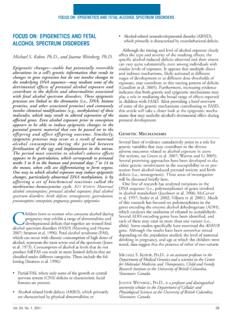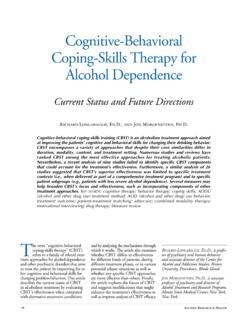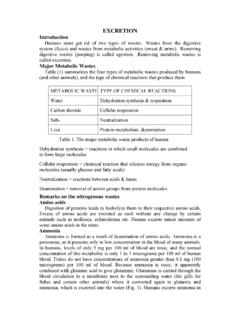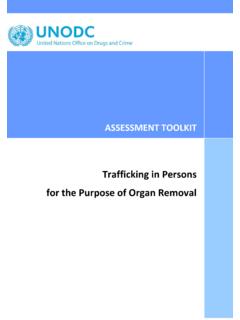Transcription of The Endocrine System - National Institutes of Health
1 The Endocrine SystemAn OverviewSusanne Hiller-Sturmh fel, , and Andrzej Bartke, plethora of hormones regulate many of the body s functions, including growth anddevelopment, metabolism, electrolyte balances, and reproduction. Numerous glandsthroughout the body produce hormones. The hypothalamus produces several releasing andinhibiting hormones that act on the pituitary gland, stimulating the release of pituitaryhormones. Of the pituitary hormones, several act on other glands located in various regionsof the body, whereas other pituitary hormones directly affect their target organs. Otherhormone-producing glands throughout the body include the adrenal glands, which primarilyproduce cortisol; the gonads ( , ovaries and testes), which produce sex hormones; thethyroid, which produces thyroid hormone; the parathyroid, which produces parathyroidhormone; and the pancreas, which produces insulin and glucagon.
2 Many of these hormonesare part of regulatory hormonal cascades involving a hypothalamic hormone, one or morepituitary hormones, and one or more target gland hormones. KEY WORDS: Endocrine function;hormones; hypothalamus; pituitary gland; gonad function; thyroid; parathyroid; pancreas;biochemical mechanism; biological feedback; biological regulation; hypothalamus-pituitaryaxis; pituitary-adrenal axis; pituitary-thyroid axis; literature reviewVol. 22, No. 3, 1998153 For the body to function properly,its various parts and organs mustcommunicate with each other toensure that a constant internal environ-ment ( , homeostasis) is example, neither the body temper-ature nor the levels of salts and minerals( , electrolytes) in the blood mustfluctuate beyond preset limits. Com-munication among various regions ofthe body also is essential for enablingthe organism to respond appropriatelyto any changes in the internal andexternal environments.
3 Two systemshelp ensure communication: the nervoussystem and the hormonal ( , neuroen-docrine) System . The nervous systemgenerally allows rapid transmission( , within fractions of seconds) ofinformation between different bodyregions. Conversely, hormonal commu-nication, which relies on the productionand release of hormones from variousglands and on the transport of thosehormones via the bloodstream, is bettersuited for situations that require morewidespread and longer lasting regulatoryactions. Thus, the two communicationsystems complement each other. Inaddition, both systems interact: Stimulifrom the nervous System can influencethe release of certain hormones andvice speaking, hormones con-trol the growth, development, andmetabolism of the body; the electrolytecomposition of bodily fluids; and repro-duction. This article provides anoverview of the hormone systemsinvolved in those regulatory article first summarizes some of thebasic characteristics of hormone-mediated communication within thebody, then reviews the various glandsinvolved in those processes and theSUSANNEHILLER-STURMH FEL, ,is a science editor of Alcohol Health &Research , , is professorand chairman of physiology at SouthernIllinois University School of Medicine,Carbondale, hormones they produce.
4 Formore in-depth information on thosehormones, the reader should consultendocrinology textbooks ( , Con-stanti et al. 1998; Wilson et al. 1998).Finally, the article presents variousendocrine systems in which hormonesproduced in several organs cooperateto achieve the desired regulatory discussions focus primarily onthe System responses in normal, healthypeople. For information regardingalcohol s effects on some of the hormonesystems, the reader is referred to sub-sequent articles in this issue of AlcoholHealth & Research Are Hormones?Hormones are molecules that are pro-duced by Endocrine glands, includingthe hypothalamus, pituitary gland,adrenal glands, gonads, ( , testes and ovaries), thyroid gland, parathyroidglands, and pancreas (see figure 1). The term Endocrine implies that inresponse to specific stimuli, the productsof those glands are released into hormones then arecarried via the blood to their targetcells. Some hormones have only a fewspecific target cells, whereas otherhormones affect numerous cell typesthroughout the body.
5 The target cellsfor each hormone are characterized bythe presence of certain docking mole-cules ( , receptors) for the hormonethat are located either on the cell surfaceor inside the cell. The interactionbetween the hormone and its receptortriggers a cascade of biochemical reac-tions in the target cell that eventuallymodify the cell s function or of ActionSeveral classes of hormones exist, includ-ing steroids, amino acid derivatives,and polypeptides and proteins. Thosehormone classes differ in their general molecular structures ( , size andchemical properties). As a result of thestructural differences, their mechanismsof action ( , whether they can entertheir target cells and how they modulatethe activity of those cells) also , which are produced by thegonads and part of the adrenal gland( , the adrenal cortex), have a molecularstructure similar to that of molecules can enter their targetcells and interact with receptors in thefluid that fills the cell ( , the cytoplasm)or in the cell nucleus.
6 The hormone-receptor complexes then bind to certainregions of the cell s genetic material ( ,the DNA), thereby regulating the activ-ity of specific hormone-responsive acid derivatives are modi-fied versions of some of the buildingblocks of proteins. The thyroid glandand another region of the adrenalglands ( , the adrenal medulla) pro-duce this type of hormone ( , theamino acid derivatives). Like steroids,amino acid derivatives can enter the154 Alcohol Health & Research World1 Conversely, exocrine glands ( , sweat glandsand salivary glands) release their secretions to theoutside of the body ( , sweat) or into a hollowspace that is open to the outside ( , salivareleased into the mouth).Hypothalamus Pituitary glandThyroid glandParathyroid glandTestis (in male)Pancreas(Islets of Langerhans)Adrenal gland Ovary(in female)Figure 1 Schematic representation of the location of the major hormone-producing( , Endocrine ) organs in the body. (For the purposes of illustration, bothmale and female Endocrine organs are presented here.)
7 Cell, where they interact with receptorproteins that are already associatedwith specific DNA regions. Theinteraction modifies the activity ofthe affected and protein hormonesare chains of amino acids of variouslengths (from three to several hundredamino acids). These hormones arefound primarily in the hypothalamus,pituitary gland, and pancreas. In someinstances, they are derived from inactiveprecursors, or pro-hormones, whichcan be cleaved into one or more activehormones. Because of their chemicalstructure, the polypeptide and proteinhormones cannot enter cells. Instead,they interact with receptors on thecell surface. The interaction initiatesbiochemical changes in either the cell smembrane or interior, eventually mod-ifying the cell s activity or of Hormone ActivityTo maintain the body s homeostasisand respond appropriately to changesin the environment, hormone produc-tion and secretion must be tightlycontrolled. To achieve this control,many bodily functions are regulatednot by a single hormone but by severalhormones that regulate each other (see figure 2).
8 For example, for manyhormone systems, the hypothalamussecretes so-called releasing hormones,which are transported via the blood tothe pituitary gland. There, the releasinghormones induce the production andsecretion of pituitary hormones, whichin turn are transported by the blood totheir target glands ( , the adrenalglands, gonads, or thyroid). In thoseglands, the interaction of the pituitaryhormones with their respective targetcells results in the release of the hormonesthat ultimately influence the organstargeted by the hormone cascade. Constant feedback from the targetglands to the hypothalamus and pitu-itary gland ensures that the activity ofthe hormone System involved remainswithin appropriate boundaries. Thus,in most cases, negative feedback mech-anisms exist by which hormonesreleased by the target glands affectthe pituitary gland and/or hypo-thalamus (see figure 2). When certainpredeterminedblood levels of thosehormones are reached, the hypothala-mus and/or the pituitary ceaseshormone release, thereby turning off the cascade.
9 In some instances, aso-called short-loop feedback occurs,in which pituitary hormones directlyact back on the hypothalamus. The sensitivity with which thesenegative feedback systems operate( , the target hormone levels thatare required to turn off hypothalamicor pituitary hormone release) canchange at different physiological statesor stages of life. For example, theprogressive reduction in sensitivity of the hypothalamus and pituitary tonegative feedback by gonadal steroidhormones plays an important role insexual negative feedback ismore common, some hormone systems are controlled by positivefeedback mechanisms, in which atarget gland hormone acts back onthe hypothalamus and/or pituitary to increase the release of hormonesthat stimulate the secretion of thetarget gland hormone. One suchmechanism occurs during a woman smenstrual period: Increasing estrogenlevels in the blood temporarily stimulate, rather than inhibit, hormonerelease from the pituitary and hypo-thalamus, thereby further increasingVol.
10 22, No. 3, 1998155 The Endocrine SystemReleasing hormonePituitary hormoneTarget gland hormoneShort-loop feedbackHypothalamusFigure 2 Schematic representation of negative feedback mechanisms that controlendocrine System activity. In many cases, the hormones released from thetarget gland act back on the pituitary and/or hypothalamus, repressingfurther hormone release from both organs and thereby shutting off thesystem. For a short-loop negative feedback mechanism, pituitary hormonesact directly back on the hypothalamus, inhibiting the release of : + = stimulates; = pituitaryTarget gland156 Alcohol Health & Research WorldHormones Produced by the major Hormone-Producing ( , Endocrine ) Glands and Their Primary Functions Endocrine GlandHormonePrimary Hormone FunctionHypothalamusCorticotropin-releas ing hormone (CRH)Stimulates the pituitary to release adrenocorticotropichormone (ACTH)Gonadotropin-releasing hormone (GnRH)Stimulates the pituitary to release luteinizing hormone (LH) and follicle-stimulating hormone (FSH)Thyrotropin-releasing hormone (TRH)Stimulates the pituitary to release thyroid-stimulating hormone (TSH) Growth hormone-releasing hormone Stimulates the release of growth hormone (GH) from the(GHRH)pituitarySomatostatinInhibits the release of GH from the pituitaryDopamineInhibits the release of prolactin from the pituitaryAnterior pituitary glandACTHS timulates the release of hormones from the adrenal cortexLHIn women, stimulates the production of sex hormones ( ,estrogens)
